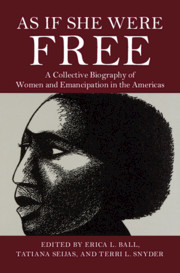Book contents
- As If She Were Free
- As If She Were Free
- Copyright page
- Dedication
- Contents
- Figures
- Contributors
- Elizabeth Catlett and the Form of Emancipation
- Acknowledgments
- Introduction
- Part I Claiming Emancipation during the Rise of New World Slavery
- 1 Margarita de Sossa, Sixteenth-Century Puebla de los Ángeles, New Spain (Mexico)
- 2 Paula de Eguiluz, Seventeenth-Century Puerto Rico, Cuba, and New Granada (Colombia)
- 3 Reytory Angola, Seventeenth-Century Manhattan (US)
- 4 Elizabeth Key, Seventeenth-Century Virginia (US)
- 5 Hannah Manena McKenney, Late Seventeenth- and Early Eighteenth-Century Bermuda and New Providence (Bahamas)
- 6 Juana de Godinez, Seventeenth-Century Lima (Peru)
- Part II Experiencing Freedom during Slavery’s Expansion
- Part III Envisaging Emancipation during Second Slavery
- Part IV Enacting Emancipation in the Aftermath of Slavery
- Bibliography
- Index
6 - Juana de Godinez, Seventeenth-Century Lima (Peru)
from Part I - Claiming Emancipation during the Rise of New World Slavery
Published online by Cambridge University Press: 24 September 2020
- As If She Were Free
- As If She Were Free
- Copyright page
- Dedication
- Contents
- Figures
- Contributors
- Elizabeth Catlett and the Form of Emancipation
- Acknowledgments
- Introduction
- Part I Claiming Emancipation during the Rise of New World Slavery
- 1 Margarita de Sossa, Sixteenth-Century Puebla de los Ángeles, New Spain (Mexico)
- 2 Paula de Eguiluz, Seventeenth-Century Puerto Rico, Cuba, and New Granada (Colombia)
- 3 Reytory Angola, Seventeenth-Century Manhattan (US)
- 4 Elizabeth Key, Seventeenth-Century Virginia (US)
- 5 Hannah Manena McKenney, Late Seventeenth- and Early Eighteenth-Century Bermuda and New Providence (Bahamas)
- 6 Juana de Godinez, Seventeenth-Century Lima (Peru)
- Part II Experiencing Freedom during Slavery’s Expansion
- Part III Envisaging Emancipation during Second Slavery
- Part IV Enacting Emancipation in the Aftermath of Slavery
- Bibliography
- Index
Summary
This contribution assesses the legal struggle of Juana Godínez to enforce the last will and testament of her owner that she remain within the cloisters of La Encarnación (a cloister for wealthy Limeña doncellas in the seventeenth century) as a free person. Juana had to fight to remain within La Encarnación as free. According to the terms of the will, if she were to leave the convent, she would have to pay 400 pesos for her freedom. Did her owner’s testament in fact grant Juana autonomy to choose how she would live her life after her death, or did the testament give her an option to remain within the cloister (the only home she had ever known) as a freedwoman? The fact that Juana “chose” to remain within the cloister while litigating her case, and that she refused the option of self- purchase prompts us to think of what freedom meant to enslaved women who belonged to religious communities. Juana’s case—and her alleged choices afford us an opportunity to think through freedom in the early modern slaveholding world.
- Type
- Chapter
- Information
- As If She Were FreeA Collective Biography of Women and Emancipation in the Americas, pp. 110 - 128Publisher: Cambridge University PressPrint publication year: 2020



